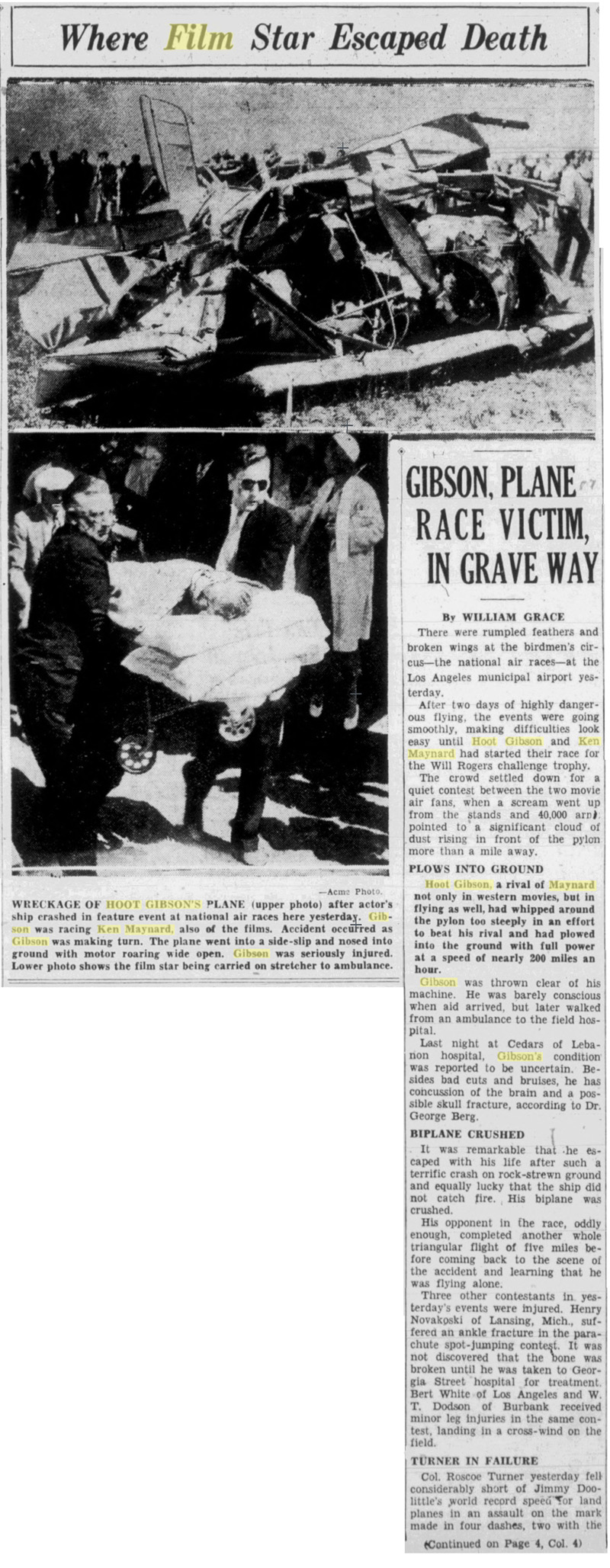






























|
|
Note: "OLLP" at then end of a text block indicates the text was taken from On Location in Lone Pine by Dave Holland. |
Lone Pine Film History Museum
Lone Pine, Where the Real West Becomes the Reel West
Movies/Documentaries/TV Series Filmed in Owens Valley
MAJOR FILMING AREAS IN THE ALABAMA HILLS |


For years, the sprawling boulders of the Alabama Hills were Hollywood's perennial substitute for India's rugged Northwest Frontier. From the mid-thirties into the '50's, if it was about the British Army preserving the Empire, they shot it at Lone Pine and we believed every dust second of it. Even today, when you hike through the Alabams, you half expect to hear a distant bagpipe or bugle... that's how vivid the memories are. At the head of the column, sitting ram-rod straight in the saddle, is Errol Flynn or Gary Cooper, or Cary Grant and Victor McLaglen and Douglas Fairbanks Jr. Behind them the eager junior officers, David Niven or Franchot Tone or Patric Knowles, always so anxious, so impulsive. But who could blame these gallant young men? This was, after all, the land of Kipling, the land of the Bengal Lancers and the Khyber Rifles, the land of adventure and romance and danger. They believed it, we believed it. And for a detailed look behind-the-scenes at Lone Pine's hallmark British Army film, see Gunga Din - the making of a classic. [Gunga Din - the making of a classic is in Dave Holland's book - On Location in Lone Pine] OLLP |
 |
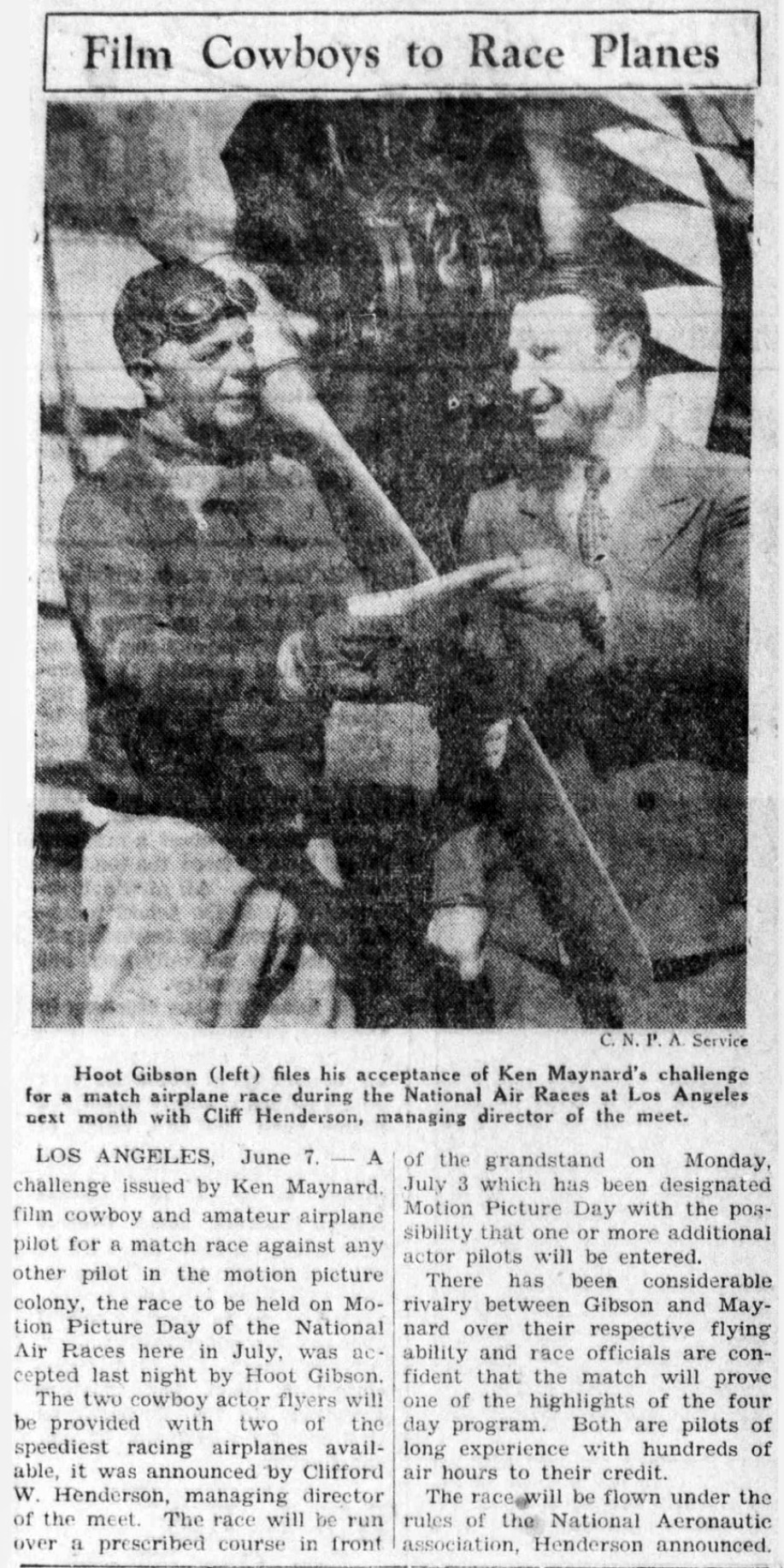 From the "Calexico Chronicle" of June 7, 1933 Hoot GIbson and Ken Maynard to face off in National Air Races at Los Angeles |
 |
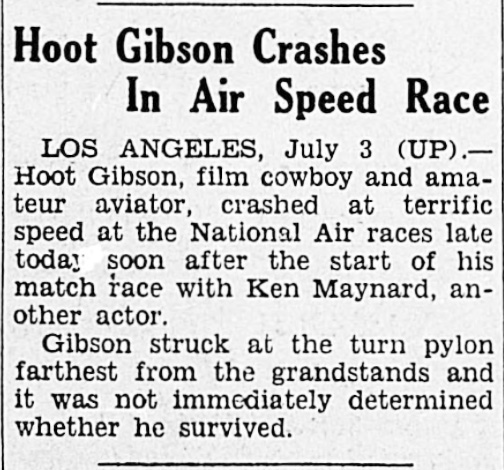 From the "San Pedro News-Pilot" of July 3, 1933 Hoot Gibson crashes in air speed race at the National Air Races just held in Los Angeles. |
The Western Stars |
|||
Rex Allen 1920-1999 |
|||
 |
Slim Andrews 1906-1992 |
||
 |
Richard Boone 1917-1981 |
||
 |
Yul Brynner 1920-1985 |
||
 |
|||
Yakima Canutt 1895-1986 |
|||
 |
|||
Buster Crabbe 1908-1983 |
|||
 |
|||
Andy Devine 1905-1977 |
|||
 |
|||
Dick Foran 1910-1979 |
|||
 |
|||
Glenn Ford 1916-2006 |
|||
 |
|||
Gene Hackman 1930- |
|||
 |
|||
William S. Hart 1864-1946 |
|||
 |
|||
Tim Holt 1919-1974 |
|||
 |
|||
Guy Madison 1922-1996 |
|||
 |
|||
Tim McCoy 1891-1978 |
|||
 |
|||
Robert Mitchum 1917-1997 |
|||
 |
|||
Bob Nolan 1908-1980 |
|||
 |
|||
Jack Palance 1919-2006 |
|||
 |
|||
Bill Pickett 1870-1932 |
|||
 |
|||
Tyrone Power 1914-1958 |
|||
 |
|||
Whip Wilson 1911-1964 |
|||
 |
|||

Zane Grey's "Born to the West" - 1937
John Wayne and Marsha Hunt also starring Johnny Mack Brown
Not quite three miles west of that [lone] traffic light, that road turning off north into the rocks is officially called Movie Road. It was kept the flattest and smoothest by the film companies all those years for use as an "insert road" - which means this: Say you have a long shot of Roy Rogers dashing along on Trigger but yo want to cut to a close-up occasionally (to show that it's really Roy riding so fast and so dangerously and not his long-time stunt double, Joe Yrigoyen). That close-up will be inserted into the long shot and to get that shot, the camera obviously needs to be closer so special insert roads were built which allowed the heavily weighted camera cars (sometimes called insert cars) to drive along just as fast but twice as smoothly and film the horses or wagons running alongside. More? Locals still call that whole area west of Movie Road "Movie Flats." And on the east side of Movie Road is a certain narrow road twisting through the rocks called "Lone Ranger Canyon." And since Indian actor Chief Thundercloud played Tonto in the Republic serials about the masked man, there's a "Thundercloud Lane" in the Alabama Hills residential area (go South on Horseshoe Meadow Road and left on Sunset). Then there's Gene Autry Rock and Gary Cooper Rock and the Backgroind Rocks and the Lone Ranger Ambush Sit. Not to mention Bogart Curve and Bengal Curve. You'll know them all before we're through. Meanwhile, back on Whitney Portal Road, that whole S-curve area where the road dips down to cross Lone Pine Creek just west of the Movie Road turn-off is called "Red Dog" because of what went on there 60 years ago! For a big 1930 Technicolor musical-western with John Boles called Song of the West, Warner Brothers built a rather large town on those still-bare flats north of the road just west of the crossing. There was a Red Dog Saloon in town - the town itself may have been called Red Dog, too - and the buildings remained in place for so long afterwards, the name stuck - to this day! OLLP |

 |
|
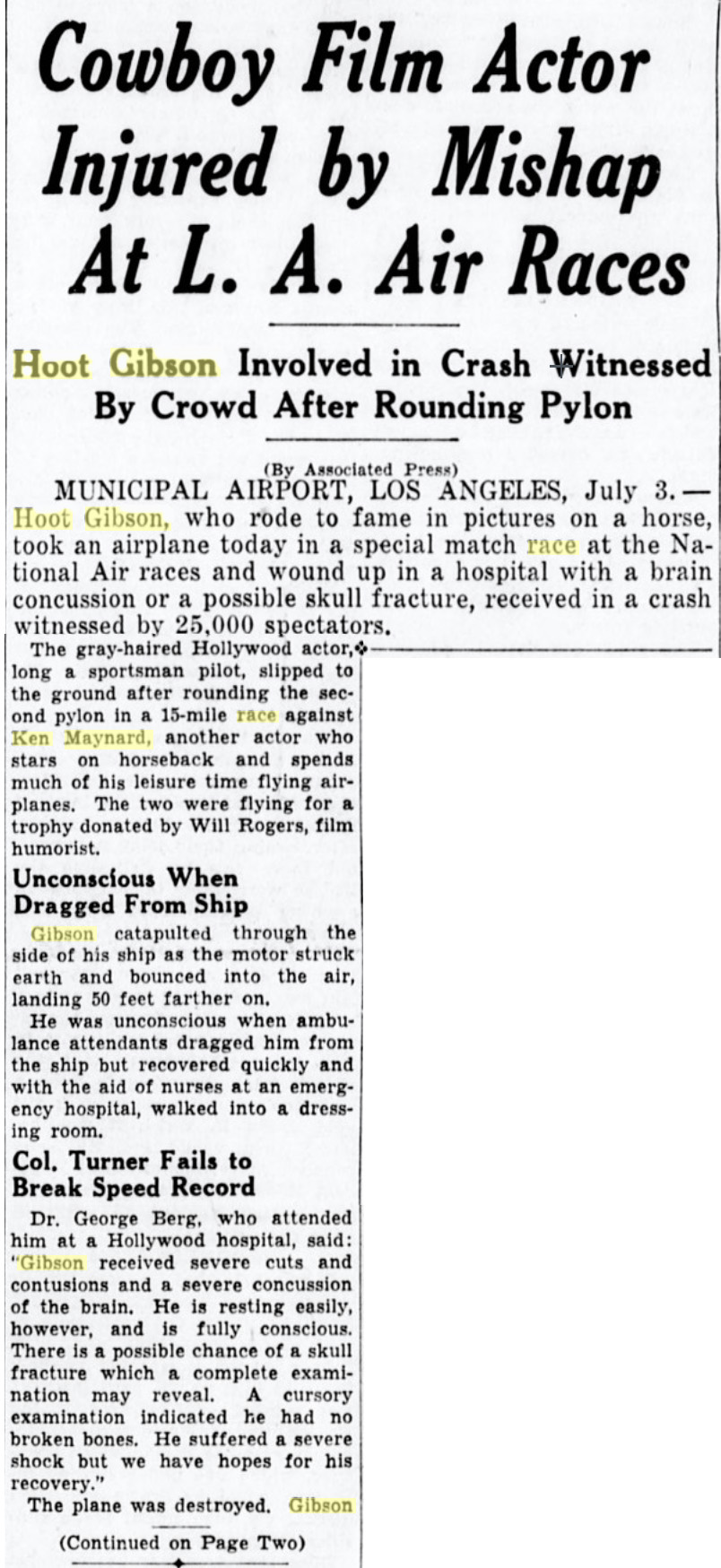 From the "San Bernardino Daily Sun" of July 4, 1933 Hoot GIbson injured in National Air Races at Los Angeles |
 |
Usually, movie companies took down their sets as soon as filming was completed, selling or giving away the debris, much to the delight of Lone Pine residents. Dr. and Mrs. George Shultz used the wood from the Rawhide stage station (Fox 1951) to build a cabin along Lone Pine Creek. Lumber from the Yellow Sky house and barn (Fox 1948) did double duty: it went into a new home for the Clarence Christenson family and a cabin for Don and Alice Homer. Paramount turned over its Star Trek V sets to Jodi Stewart and Mike Patterson to use renovating the old mining town of Cerro Gordo. And when Gunga Din's big native village of Tantrapur set was taken down in 1938, Russ Spainhower trucked remnants of that to his Anchor Ranch at the southern edge of town on U.S. 395 and began building the only permanent set Lone Pine had for years, a mission/hacienda/ranch house complex. OLLP |
Images from Yellow Sky - 1948 |
||
 |
|
 L/R: Leonard Nimoy, George Takei, Walter Koenig, James Doohan, DeForest Kelley, Nichelle Nichols, William Shatner |
|

Images from Rawhide - 1951 |
|
 |
|
 |
|
Images from Westward Ho - 1935 |
|
The Round-Up (1920)
(Courtesy Museum of Western Film History)
Images from The Roundup - 1920 |
|
 Roscoe (Fatty) Arbuckle |
|
 |
 From the "Madera Daily Tribune" of July 5, 1933 Hoot Gibson is improved following his crash at the National Air Races held recently in Los Angeles |
 |
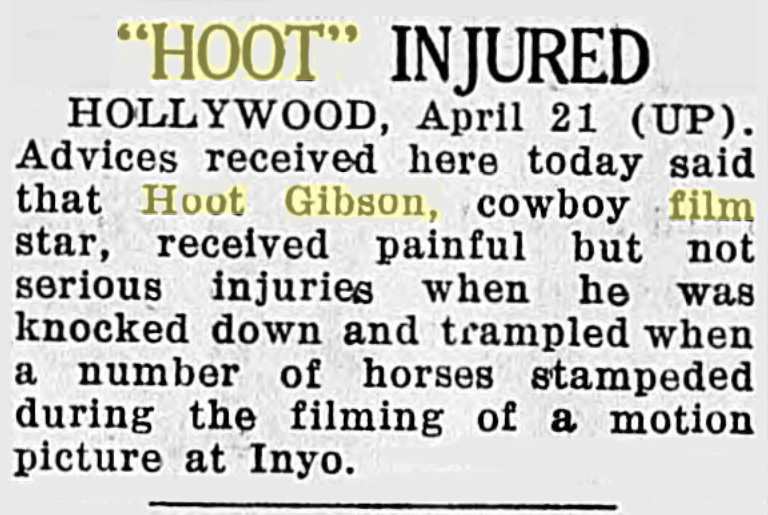 From the "San Pedro News-Pilot" of April 21, 1928 Hoot Gibson suffers painful but not serious injuries when he is trampled by a horse stampede. |
| Monache Meadows Cowboys | ||
Sam Lewis & Sierra Lady Pack Station |
||
| Ed Brown - Mt. Whitney Pack Trains Packer and Cowboy Poet | ||
More At the Movies ... in Lone Pine |
Sign Guestbook View Old Guest Book Entries Oct 1999 - Feb 2015 (MS Word) |
 CONTACT the Pigmy Packer |
View Guestbook View Old Guest Book Entries Oct 1999 - Feb 2015 (PDF) |





















